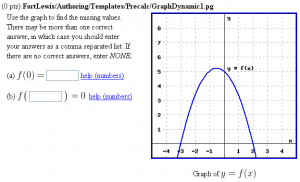Difference between revisions of "DynamicGraph1"
| Line 153: | Line 153: | ||
</p> |
</p> |
||
<p> |
<p> |
||
| − | Using a <code>ColumnTable</code> is best because in HTML mode the text and graph will be side by side, while in the PDF output the columns will be stacked on top of each other so that the text is on top of the graph. Pay attention to the size of your graph in HTML and in PDF output, and make it big enough to read easily in either format |
+ | Using a <code>ColumnTable</code> is best because in HTML mode the text and graph will be side by side, while in the PDF output the columns will be stacked on top of each other so that the text is on top of the graph. Pay attention to the size of your graph in HTML and in PDF output, and make it big enough to read easily in either format. |
| + | </p> |
||
| + | <p> |
||
| + | Many existing questions generate image files with larger dimensions than necessary, but scale them down so as to be unreadable in HTML and PDF output, which makes them hard or impossible to use. If you have the time to make a graph, take the extra time to make it an appropriate size in both HTML and PDF output. |
||
</p> |
</p> |
||
</td> |
</td> |
||
Revision as of 02:31, 4 December 2010
Dynamically Generated Graph
This PG code shows how to create a dynamically generated graph with labels that is appropriately sized and positioned.
- Download file: File:DynamicGraph1.txt (change the file extension from txt to pg when you save it)
- File location in NPL:
FortLewis/Authoring/Templates/Precalc/DynamicGraph1.pg
| PG problem file | Explanation |
|---|---|
|
Problem tagging: |
|
DOCUMENT(); loadMacros( "PGstandard.pl", "MathObjects.pl", "AnswerFormatHelp.pl", "PGgraphmacros.pl", "unionTables.pl", ); TEXT(beginproblem()); $refreshCachedImages = 1; |
Initialization:
It is important to set |
Context("Numeric");
$a = random(2,3,1); # left x-intercept
$b = random(2,4,2); # right x-intercept
$c = random(5,6,1); # y-intercept
$k = -($c)/($a * $b);
$A = $k;
$B = $k*($a - $b);
$C = -($k * $a * $b);
#
# Graph canvas
#
$gr = init_graph(-5,-1,5,9,axes=>[0,0],grid=>[10,10],size=>[300,300]);
$gr -> lb('reset');
#
# Graph labels and functions
#
$gr -> lb(new Label ( 4.5,0,'x','black','left','bottom'));
$gr -> lb(new Label ( 0.25,8.5,'y','black','left','bottom'));
$gr -> lb(new Label ( 0.25,$c,'y = f(x)','black','left','bottom'));
foreach my $i (1..4) {
$gr -> lb(new Label ( $i,-0.5, $i,'black','center','middle'));
$gr -> lb(new Label (-$i,-0.5,-$i,'black','center','middle'));
}
foreach my $j (1..8) {
$gr -> lb(new Label (-4.5,$j,$j,'black','center','middle'));
}
add_functions($gr, "$A*x**2+$B*x+$C for x in <-5,5> using color:blue and weight:2");
|
Setup:
For more details on the graph object |
Context()->texStrings;
BEGIN_TEXT
\{
ColumnTable(
"Use the graph to find the missing values.
There may be more than one correct answer,
in which case you should enter your answers
as a comma separated list. If there are no
correct answers, enter ${BITALIC}NONE.${EITALIC}
$BR
$BR
(a) \( f(0) = \) " .
ans_rule(7).$SPACE.
AnswerFormatHelp("numbers").
"$BR
$BR
(b) \( f \big( \) ".ans_rule(7)." \( \big) = 0 \). ".
AnswerFormatHelp("numbers")
,
image(insertGraph($gr), width=>300, height=>300, tex_size=>700).
$BR.$BCENTER.
$BR.
"Graph of \( y = f(x) \)".
$ECENTER
,
indent => 0, separation => 30, valign => "TOP"
)
\}
END_TEXT
Context()->normalStrings;
|
Main Text:
We use a two column format provided by
Using a Many existing questions generate image files with larger dimensions than necessary, but scale them down so as to be unreadable in HTML and PDF output, which makes them hard or impossible to use. If you have the time to make a graph, take the extra time to make it an appropriate size in both HTML and PDF output. |
$showPartialCorrectAnswers = 1; ANS(List($c)->cmp() ); ANS(List(-$a,$b)->cmp() ); |
Answer Evaluation: |
Context()->texStrings;
BEGIN_SOLUTION
${PAR}SOLUTION:${PAR}
Solution explanation goes here.
END_SOLUTION
Context()->normalStrings;
COMMENT('MathObject version.');
ENDDOCUMENT();
|
Solution: |
